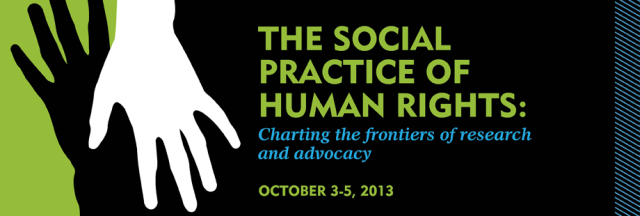Eyes in the Sky: Satellite Technology and Human Rights
Location
River Campus - Room M2006
Start Date
10-4-2013 3:15 PM
Abstract
Human rights has long attempted to prevent violence by “watching” conflict zones. When Amnesty International launched its “Eyes on Darfur” campaign, however, it introduced a new way of witnessing human rights abuses – not through the self or screen, but through the eye of a machine. Using Darfur and Sudan as case studies, this paper considers the new promises and challenges geospatial technologies offer human rights.
Satellite imagery is unlike humanitarian photography. Its subject is not a face or a body, but buildings, roads, bridges, and land. Unlike a citizen who is subjectively emerged in conflict, a satellite is miles above ground, capturing only an aerial view. Yet despite its seeming lack of emotion, these images have been far from unpersuasive. Organizations, from the Satellite Sentinel Project to the American Association for the Advancement of Science, are using satellite data prominently in their campaigns. Their stark objectivity is, in fact, what makes them attractive to organizations aiming to provide audiences with a sense of urgency and raw reality. Furthermore, while satellite imagery originally required expert interpretation, organizations such as AAAS are providing step-by-step instructions on how to analyze data, attempting to open “expert” discourses to ordinary citizens. This paper, then, will explore differences between scientific and subjective witnessing, expert and citizen testimony, and personal versus structural narrative in human rights. Ultimately, this paper will propose ways in which organizations may better use satellite technology, such as how to intervene objectivity with empathy and more effectively engage the public.
Eyes in the Sky: Satellite Technology and Human Rights
River Campus - Room M2006
Human rights has long attempted to prevent violence by “watching” conflict zones. When Amnesty International launched its “Eyes on Darfur” campaign, however, it introduced a new way of witnessing human rights abuses – not through the self or screen, but through the eye of a machine. Using Darfur and Sudan as case studies, this paper considers the new promises and challenges geospatial technologies offer human rights.
Satellite imagery is unlike humanitarian photography. Its subject is not a face or a body, but buildings, roads, bridges, and land. Unlike a citizen who is subjectively emerged in conflict, a satellite is miles above ground, capturing only an aerial view. Yet despite its seeming lack of emotion, these images have been far from unpersuasive. Organizations, from the Satellite Sentinel Project to the American Association for the Advancement of Science, are using satellite data prominently in their campaigns. Their stark objectivity is, in fact, what makes them attractive to organizations aiming to provide audiences with a sense of urgency and raw reality. Furthermore, while satellite imagery originally required expert interpretation, organizations such as AAAS are providing step-by-step instructions on how to analyze data, attempting to open “expert” discourses to ordinary citizens. This paper, then, will explore differences between scientific and subjective witnessing, expert and citizen testimony, and personal versus structural narrative in human rights. Ultimately, this paper will propose ways in which organizations may better use satellite technology, such as how to intervene objectivity with empathy and more effectively engage the public.




Comments
This biennial conference provides a unique space for scholars, practitioners and advocates to engage in collaboration, dialogue and critical analysis of human rights advocacy — locally and globally. Learn more about the Human Rights Center at the University of Dayton >>>.